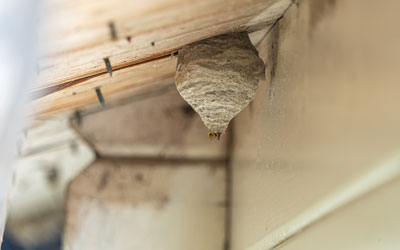If you’ve seen a growing number of wasps near your home, there could be a nest nearby! Different types of these stinging insects build different types of nests, making it important to learn how to identify a wasp nest. When it comes to nests, it’s important to be extremely cautious around them. Many types of wasps are very defensive when it comes to defending their nest. Even if it looks abandoned, always exercise caution. The team at Batzner Pest Control is here to share all you need to know when it comes to identifying wasp nests you may come across in Wisconsin.
What do Wasp Nests Look Like?
The below stinging insects build different types of nests. They can be identified by the following features and characteristics:
- Yellowjackets. Nests are a papery material and have a single opening. The inside of a yellowjacket nest can have up to 100 tiers of cells. Yellowjackets can also build underground nests that can be enormous in size.
- Paper wasps. Their nests famously look like upside-down umbrellas. These nests are often open, and can get quite large in size. They are typically supported by a single stalk and consist of a paper-like material.
- Mud daubers. True to name, these nests are made out of mostly mud. The nests are small and tubular in size, often looking like organ pipes. They are typically found in cracks or crevices.
- Bald-faced hornets. These nests are almost always at least three feet off the ground. They are made of chewed wood fibers mixed with saliva. They often grow to be the size of a football or basketball.
Where are Wasp Nests Found?
Wasp nests can be found in a variety of areas. Paper wasp nests can be located under and within the eaves of structures, in attics and wall voids, and in other enclosed areas. Yellowjackets favor areas near the ground, in hollow trees, under porches, and a number of other areas. Mud daubers tend to build their nests in sheltered areas, including under eaves, garages, attics, or on the sides of buildings. Lastly, the bald-faced hornet builds its nest oftentimes in trees, bushes, or wooded areas.
How to Get Rid of a Wasp Nest
If you notice a large number of wasps flying to and from a specific area, there is a high chance there is a nest nearby. It’s never recommended to deal with wasp nests on your own. Certain wasps can sting multiple times and tend to get especially aggressive when they feel threatened. If you spot a nest, always contact your local wasp control experts at Batzner.


